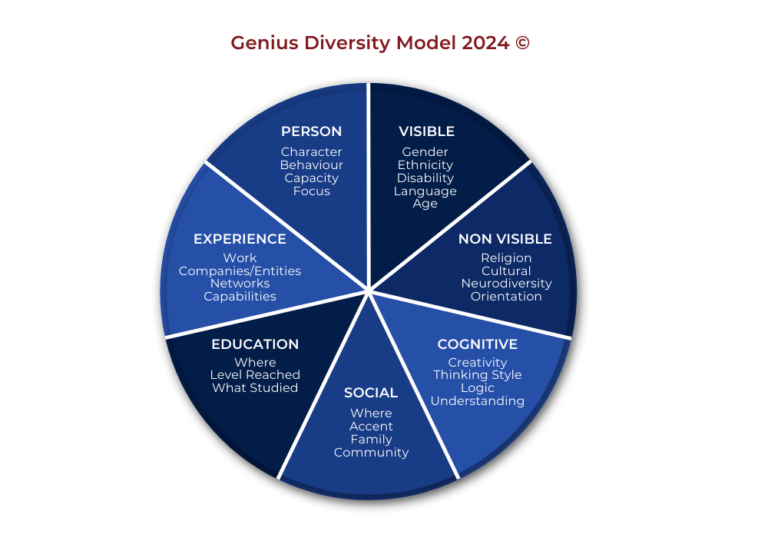Why Strategic Blind Spots Still Exist - Despite Demographic Progress
Boards have made progress on gender and ethnic diversity, but why do strategic blind spots persist?
While many boards have achieved demographic balance, they often struggle with deeper issues of cognitive and experiential diversity. True diversity goes beyond who sits at the table; it’s about how decisions are made and how effectively directors challenge assumptions and identify risks.
The business case for diversity is well established. Diverse boards are more adaptable, innovative, and better positioned to respond to market volatility. However, traditional diversity models focus heavily on demographic targets. Cognitive and experiential diversity, the diversity of thinking styles, problem-solving approaches, and professional backgrounds are the real drivers of strategic strength.
Many boards have approached diversity as a static target, an end in itself. But diversity is not just a checkbox. It’s the outcome of inclusive, equity-driven governance. As outlined in our earlier perspective on DEI, when boards treat diversity as the result of a strong culture and structure, not merely the starting point, they unlock its true strategic value.
To unlock the full value of diversity, boards should move beyond representation and embed it into governance structures, decision-making processes, and leadership development.
It’s not only about who sits at the table; it’s also about how they think.
Beyond Traditional Diversity Metrics
For decades, boards have measured diversity through visible factors like gender, ethnicity, and age. While these are important, they are not enough to deliver sustained competitive advantage.
Traditional diversity models focus on who sits at the table; cognitive and experiential diversity determine how decisions are made. Combined, they enhance decision-making quality, foster innovation, and improve a board’s ability to adapt to market shifts.
Cognitive diversity refers to the different ways directors think, process information, and solve problems. Experiential diversity encompasses varied professional backgrounds, cultural influences, and industry insights.
As Matthew Syed points out in his book Rebel Ideas, collective intelligence isn’t about assembling the most competent individuals but combining different thinking styles. A well-balanced mix of analytical and strategic thinkers leads to better decisions, greater resilience, and faster adaptation to market disruptions.
Boards that reflect diverse thinking styles and professional experiences are better positioned to identify risks, challenge assumptions, and capitalise on emerging opportunities.

The Genius Diversity Model © visualises these deeper layers of diversity, highlighting the traits that shape how directors think, decide, and lead. From visible characteristics to cognitive style and lived experience, it reflects the complex factors that influence boardroom dynamics.
Unlocking the Strategic Value of Cognitive and Experiential Diversity
When everyone at the table sees the world the same way, boards miss what matters most. With directors that share similar backgrounds, perspectives, and problem-solving styles, groupthink takes hold, and consensus becomes the default, even when it masks bias, underestimates risk or overlooks opportunity.
Cognitive diversity changes that. It brings variation in how directors process information, question assumptions, and approach decisions. Experiential diversity deepens the board’s lens, adding real-world insight drawn from different sectors, geographies, and leadership contexts.
Together, they elevate the board’s strategic capacity. The most effective boards don’t just look diverse; they think and act diversely. They don’t settle for comfortable consensus; they lean into constructive challenge. As a result, they’re better positioned to anticipate market shifts, pressure-test strategy, and lead with resilience.
Reducing Groupthink and Enhancing Risk Management
Boards that think too similarly tend to circle the same ideas. Without varied perspectives, risk conversations grow narrow, overlooking blind spots and reinforcing assumptions. Cognitive diversity cuts through that sameness, introducing a wider range of questions, interpretations, and risk tolerances.
Experiential diversity adds another layer. Directors with different market exposure, industry backgrounds, or operational track records don’t just bring new opinions; they bring new lenses. A supply chain specialist might flag a logistical vulnerability before it becomes a crisis. Someone with regulatory depth may spot compliance risks others wouldn’t think to name.
The result is more dynamic discussion and stronger oversight. A 2007 study by Parayitam and Bao found that cognitively diverse boards experience higher levels of constructive conflict. Rather than avoid disagreement, directors engage with it, challenging assumptions and pressure-testing plans. That kind of productive tension leads to better-balanced, more resilient decisions.
Enhancing Strategic Decision-Making
The best boards don’t wait to be disrupted; they see it coming and act early. That foresight doesn’t happen by chance. It’s built through a mix of thinking styles, leadership experiences, and professional insight that sharpen the board’s ability to question, adapt, and lead.
Creative minds and analytical thinkers bring contrasting lenses to the table. When combined with directors who offer operational depth and industry insight, the result is more grounded, forward-looking decision-making. Ideas are not only bold; they’re actionable.
When directors respectfully challenge each other’s views, explore alternatives, and sharpen one another’s thinking, decisions improve, not just in quality but in speed. It’s the kind of agility that modern boards need.
A 2017 study by Alison Reynolds and David Lewis (Harvard Business Review) found that cognitively diverse teams solved complex problems more quickly and effectively than homogeneous ones. That dynamic, fast-thinking edge is precisely what distinguishes boards that lead from those that follow.

Source: https://hbr.org/2017/03/teams-solve-problems-faster-when-theyre-more-cognitively-diverse
The Role of the Nominations Committee
The nominations committee plays a pivotal role in embedding cognitive and experiential diversity into board composition. Traditional nomination processes often prioritise demographic markers, such as gender, ethnicity, and age, while overlooking how candidates think, solve problems, and make decisions.
Boards that select for diverse thinking styles, combining analytical precision with strategic creativity, are more resilient and adaptive. Instead of recruiting directors with similar resumes, boards should seek a balanced mix of problem-solvers, big-picture strategists, and grounded executors.
However, selecting for diversity is only the start; how that diversity is nurtured matters just as much.
To embed meaningful diversity into the boardroom, the nominations committee should expand its selection criteria to include:
- Problem-solving approaches – Combining creative and analytical thinkers enhances strategic agility.
- Emotional intelligence (EQ) – Directors with strong EQ navigate conflict more effectively and foster inclusive dialogue.
- Decision-making styles – A mix of data-driven and intuitive preferences improves board adaptability.
- Strategic thinking capabilities – Directors who can anticipate market shifts and manage ambiguity strengthen foresight.
- Professional backgrounds and industry experience – Cross-sector insight challenges groupthink and sparks innovation.
Boards that build cognitive and experiential diversity into recruitment frameworks elevate both strategic performance and governance maturity. The nominations committee sets the tone by defining the mix of thinking styles, decision-making strengths, and experiences needed around the table, not just for today but for the future. This directly contributes to long-term board leadership effectiveness.
Creating a Culture That Supports Independent Thinking
Boards can’t rely on diversity metrics alone. To unlock the benefits of cognitive and experiential diversity, leadership must set the tone from the top, modelling inclusive behaviours and decision-making practices.
For cognitive and experiential diversity to drive real value, it must be embedded into boardroom culture, not treated as a compliance task. Diverse boards outperform homogeneous ones only when directors feel empowered to challenge assumptions and engage in open debate.
Without leadership commitment, diversity remains superficial. Boards that discourage dissenting views or fail to foster open dialogue miss the benefits of diverse thinking. Conformity bias (avoiding dissent to preserve harmony) and surface-level diversity (representation without meaningful input) often undermine decision-making quality.
Effective leadership is critical in embedding cognitive and experiential diversity into governance structures. Board chairs and senior leaders define the culture, setting the standard for whether diverse perspectives are valued or ignored.
📌 Key Actions for Board Leaders:
- Create a framework for independent challenge and dissent – Establish formal guidelines that empower directors to question strategic decisions without fear of reputational risk.
- Encourage directors to present alternative viewpoints – Treat dissenting opinions as a governance strength rather than a threat to cohesion.
- Provide training on emotional intelligence and active listening – Improve decision-making quality by helping directors manage conflict and integrate diverse perspectives.
Boards that model inclusive behaviours and reward independent thinking are more likely to anticipate market shifts, manage risk, and drive innovation. This kind of inclusive boardroom culture is essential to unlocking the benefits of cognitive and experiential diversity. A strong tone from the top, where directors feel empowered to challenge assumptions and engage in open strategic dialogue, creates the foundation for true cognitive and experiential diversity and strengthens governance resilience.
To explore how inclusion plays out in the boardroom—through tone, dynamics, and behavioural signals, read our boardroom perspective on DEI.
Aligning Diversity with Governance and Strategy
Boards should integrate cognitive and experiential diversity into governance frameworks to strengthen strategic decision-making. Diversity at the board level is not just about representation; it enhances governance strength and improves a company’s ability to manage complex risks and market challenges.
Boards that reflect a range of thinking styles and professional backgrounds are more adaptable and resilient in volatile business environments. Diverse perspectives help identify blind spots, challenge assumptions, and improve strategic alignment with stakeholder expectations. A well-balanced board brings together strategic vision and operational insight, ensuring more measured and effective responses to market shifts and competitive threats.
Cognitive and experiential diversity strengthen a board’s ability to anticipate disruption and respond strategically. Homogeneous boards are prone to confirmation bias and reactive decision-making, while cognitively diverse boards are more likely to:
- Detect emerging risks earlier – Diverse perspectives reveal blind spots in market shifts and regulatory changes.
- Develop balanced responses – A mix of risk-takers and conservative thinkers leads to more measured decisions.
- Navigate stakeholder pressure – Varied viewpoints improve alignment with stakeholder priorities.
📌 Key Governance Strategies:
- Board Composition – Define selection criteria that balance analytical, strategic, and creative thinking styles. A balanced board reflects both strategic vision and operational depth.
- Strategic Risk Management – Establish diverse subcommittees focused on specific risks (e.g., cyber, geopolitical). These cross-functional groups break down silos, enabling faster insights and broader scrutiny across operational areas.
- Scenario Planning – Conduct simulations involving directors with varied decision-making styles to test strategic resilience and uncover potential blind spots.
Boards that align cognitive and experiential diversity with governance structures are more adaptable, resilient, and competitive. This alignment strengthens decision-making, helping boards navigate complexity and seize strategic opportunities.
Future-Proofing Diversity in the Modern Boardroom
Achieving diversity at the recruitment stage is only the beginning. To make diversity a sustainable advantage, boards must embed it into leadership development, decision-making processes, and performance evaluation. Relying solely on demographic targets risks surface-level diversity without meaningful impact.
Cognitive and experiential diversity drive sharper decisions, stronger risk oversight, and greater adaptability. To future-proof diversity, boards should assess how different perspectives shape strategic thinking, not just who is represented.
Beyond Representation Metrics
Demographic diversity remains important, but it’s only one dimension. True board effectiveness depends on the thinking styles, professional backgrounds, and decision-making approaches directors bring to the table.
Boards that focus only on demographic targets risk overlooking critical blind spots. By contrast, cognitive and experiential diversity help boards challenge assumptions, anticipate risks, and align more closely with evolving stakeholder expectations.
📌 Key Actions for Boards:
- Structured Reviews – Evaluate how diverse perspectives influence strategic outcomes and risk mitigation.
- Performance Evaluations – Assess how directors challenge assumptions and contribute to decision-making.
- Diversity Audits – Go beyond headcount. Measure the board’s mix of cognitive approaches and experiential insight.
Leadership Evaluations and Succession Planning
Sustainable board diversity requires leadership pipelines that blend different ways of thinking. Boards that recruit only for technical skills risk creating teams that lack strategic adaptability.
📌 Key Actions for Boards:
- Balanced Leadership Pipelines – Develop a mix of analytical, strategic, and intuitive leadership styles.
- Diverse Succession Planning – Ensure future chairs and committee leaders bring a range of experiences and governance approaches.
- Emotional Intelligence Assessments – Complement traditional competencies with EQ to strengthen interpersonal dynamics and collaboration.
Boards that embed cognitive and experiential diversity into their governance strategy, not just recruitment, will be better equipped to navigate complexity and lead through uncertainty. This also strengthens stakeholder trust, an increasingly critical metric for board accountability. Future-proofing diversity requires moving beyond representation and building it into the board’s operating DNA.
How Genius Boards Measures What Others Miss
Structured board evaluations are among the most effective tools for identifying cognitive and experiential diversity gaps. While many evaluations focus on compliance and performance metrics, they often overlook how directors think, engage, and challenge strategic decisions, factors that directly influence boardroom effectiveness.
Boards that fail to assess these dimensions risk groupthink, strategic blind spots, and reduced adaptability to market shifts. Boards with diverse thinking styles are better equipped to anticipate risks, develop balanced strategies, and align with stakeholder expectations.
Measuring Thinking Styles, Not Just Outputs
Genius Boards takes a sophisticated approach to board evaluations by focusing on decision-making dynamics rather than just governance compliance. Genius Boards’ evaluation model combines:
- Strategic Insight – Evaluates how directors challenge assumptions and contribute to governance effectiveness.
- Leadership and Culture Assessment – Reviews the tone from the top, boardroom dynamics, and alignment with strategic objectives.
- Board Engagement Review – Measures how directors engage with complex issues and integrate diverse viewpoints into decisions.
Case Study: Strengthening Board Dynamics and Strategic Alignment
A financial services company engaged Genius Boards to address strategic misalignment and slow decision-making. The evaluation identified:
- An over-reliance on conservative decision-making styles
- Limited independent challenge in strategic discussions
- Cultural patterns that inhibited open debate
By restructuring board composition and supporting more active engagement from non-executive directors, the board achieved the following:
- Faster, more responsive decision-making
- Stronger alignment with executive leadership
- Improved adaptability to market shifts and governance challenges
Boards that assess cognitive diversity alongside governance performance build a more balanced, future-ready culture. Genius Boards’ evaluation model strengthens strategic alignment where it matters most, in the boardroom.
From Representation to Resilience
Boards that embed cognitive and experiential diversity into governance structures are better equipped to navigate complexity, manage risk, and drive sustainable value. Cognitive diversity sharpens strategic focus, enhances adaptability, and increases the board’s ability to challenge assumptions and identify blind spots before they become failures.
While traditional diversity models have focused on demographic representation, essential but limited, cognitive and experiential diversity determine how decisions are made, not just who makes them. The result is better-balanced strategies, stronger stakeholder alignment, and more resilient governance.
Diversity drives governance performance when it’s built into how boards think, not just who serves.
Genius Boards positions diversity as a strategic asset, not a compliance checkbox. Our evaluation model strengthens governance maturity and enhances long-term performance by assessing boardroom dynamics, decision-making behaviours, and leadership tone.
Boards that embrace deeper forms of diversity won’t just keep up with change; they’ll be the ones shaping it.
Accredited Board Reviewer
Providing independent Board Performance Reviews for enhanced Board effectiveness.

Genius Boards’ Commitment to Smarter Governance
At Genius Boards, we help leaders integrate governance-first strategies for DEI, ESG, and risk maturity. Would you like to explore how your board can future-proof its leadership approach? Contact Genius Boards for expert advisory and board governance solutions.




























